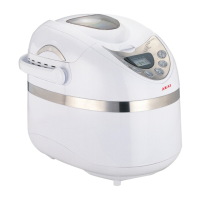9
Introduction of Bread Ingredients
1. Bread flour
Bread flour has a high gluten content (and is known to contain high amounts of
protein). It has good elasticity and can keep its shape, preventing the bread from
collapsing once it has risen. As the gluten content in bread flour is much higher
than that of common flours, it can be used for making large bread sizes with rich
fibre content. Bread flour is the most important ingredient when making bread.
2. Plain flour
Flour that contains no baking powder. It is suitable for making express bread.
3. Wholemeal flour
Wholemeal flour is made from the entire wheat berry. Wholemeal flour is heavier
and contains more nutrients than common flour. The bread made by wholemeal
flour is usually smaller in size. Many recipes combine wholemeal flour and bread
flour to achieve the best result.
4. Buckwheat flour
Buckwheat flour is a type of high fibre flour similar to wholemeal flour. It contains
no gluten so to obtain a large size after rising it must be used in combination
with a high proportion of bread flour
5. Self-raising flour
A type of flour that contains baking powder. It is commonly used for making cakes.
6. Cornmeal and oatmeal flour
Cornmeal and oatmeal flour are ground from corn and oats. They are the additive
ingredients which are used for enhancing flavour and texture.
7. Sugar
Sugar is a very important ingredient to increase the sweetness and colour of
bread. The sugar also feeds the yeast which helps the dough rise. White sugar is
usually used but other sugars may be used for particular uses.
8. Salt
Salt is necessary to improve bread flavour and crust colour. Salt can also prohibit
yeast from rising. Never use too much salt in a recipe. The less salt used, the more
the bread will expand.
9. Yeast
After the yeasting process, the yeast will produce carbon dioxide. The carbon
dioxide will expand the bread and make the inner fibre soften. However, as

